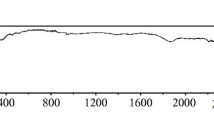Abstract
A comparative study is carried out concerning the radiation resistance of the optical properties of binders for thermal control coatings of spacecraft: widely sold liquid glass K2SiO3 and newly developed liquid glass Li2SiO3. In the case of analysis of diffuse reflectance spectra (ρλ) in the wavelength range 0.2–2.5 μm and the integral radiation-absorption coefficient (as) both before and after electron irradiation, an incomparably higher radiation resistance of Li2SiO3 liquid glass compared to K2SiO3 glass is established. The values of the change in the absorption coefficient ∆as of liquid glass Li2SiO3 comparing to that of K2SiO3 liquid glass are several times less: for electron irradiation with an estimate of 30 keV at a fluence of Ф = 2 × 1016 cm–2, it is 35 times; at Ф = 4 × 1016 cm–2, it is 25 times; and at Ф = 6 × 1016 cm–2, it is 7 times. Analysis of the factors that determine the radiation resistance of these glasses is performed. The advantage of the radiation resistance of Li2SiO3 liquid glass makes it promising for use as binding compounds in the thermal control coatings of spacecraft, in paints, ceramics and other areas of technology and industry with the presence of ionizing radiation.






Similar content being viewed by others
REFERENCES
M. M. Mikhailov, Reflection Spectra of Thermoregulating Coatings of Spacecrafts, Vol. 1 (Tomsk. Gos. Univ., Tomsk, 2007) [in Russian].
Kompozit Thermal Control Coatings: Nonmetallic Materials. https://kompozit-mv.ru/index.php/nemetallicheskie-materialy/lakokrasochnye-termoreguliruyushchie-pokrytiya.html. Cited September 16, 2022.
S. V. Tokar’ and O. P. Barinova, Tekh. Tekhnol. Silik. 26, 6 (2019).
L. G. Kositsyn, M. M. Mikhailov, N. Y. Kuznetsov, and M. I. Dvoretskii, Instrum. Exp. Tech. 28, 929 (1985).
D. A. Burns and E. W. Ciurczak, Handbook of Near-Infrared Analysis (Marcel Dekker, New York, 2001).
M. Blanco, J. Coello, H. Iturriaga, S. Maspoch, and C. Pezuela, Analyst 123, 135 (1998). http://www.doi.org/10.1039/A802531B
G. Brauer, W. Anwand, D. Grambole, J. Grenzer, W. Skorupa, J. Čížek, J. Kuriplach, I. Procházka, C. C. Ling, C. K. So, D. Schulz, and D. Klimm, Phys. Rev. B 79, 115212 (2009). http://www.doi.org/10.1103/PhysRevB.79.115212
A. Davydov, Molecular Spectroscopy of Oxide Catalyst Surfaces (Wiley, Chichester, 2003).
F. Boccuzzi, C. Morterra, R. Scala, and A. Zecchina, J. Chem. Soc., Faraday Trans. 2 77, 2059 (1981). http://www.doi.org/10.1039/F29817702059
B. M. Keyes, L. M. Gedvilas, X. Li, and T. J. Coutts, J. Crystal Growth 281, 297 (2005). http://www.doi.org/10.1016/j.jcrysgro.2005.04.053
H. Noei, H. Qiu, Y. Wang, E. Löffler, C. Wöll, and M. Muhler, Phys. Chem. Chem. Phys. 10, 7092 (2008). http://www.doi.org/10.1039/b811029h
C. D. Cooper and J. F. Mustard, Icarus 142, 557 (1999). http://www.doi.org/10.1006/icar.1999.6221
H. Okabe, Photochemistry of Small Molecules (Wiley, New York, 1978; Mir, Moscow, 1981).
N. T. Shardakov, Glass Phys. Chem. 47, 548 (2021). http://www.doi.org/10.1134/S1087659621060250
F. S. Johnson, J. Meteorol. 11, 431 (1954).
ASTM E490-00a: Standard Solar Constant and Zero Air Mass Solar Spectral Irradiance Tables (2005).
ASTM E903-96: Standard Test Method for Solar Absorptance, Reflectance, and Transmittance of Materials Using Integrating Spheres (2005).
V. M. Vladimirov and M. M. Mikhailov, RF Patent No. 2 160 294 (2000).
V. V. Neshchimenko, Doctoral Dissertation in Mathematics and Physics (Tomsk State Univ. Control Syst. Radioelectron., Tomsk, 2017).
R. Hong, T. Pan, J. Qian, and H. Li, Chem. Eng. J. 119, 71 (2006). http://www.doi.org/10.1016/j.cej.2006.03.003
E. A. Makarova and A. V. Kharitonov, Solar Energy Distribution and Solar Constant (Nauka, Moscow, 1972) [in Russian]
Funding
The work was supported by the Ministry of Science and Higher Education of the Russian Federation, the Strategic Academic Leadership Program “Priority 2030”, the project “Space Sciences and Engineering”.
Author information
Authors and Affiliations
Corresponding authors
Ethics declarations
The authors declare that they have no conflicts of interest.
Rights and permissions
About this article
Cite this article
Mikhailov, M.M., Lapin, A.N., Yuryev, S.A. et al. Properties and Prospects for the Application of Lithium Liquid Glass in the Thermal Control Coatings of Spacecraft. J. Surf. Investig. 17, 568–573 (2023). https://doi.org/10.1134/S1027451023030126
Received:
Revised:
Accepted:
Published:
Issue Date:
DOI: https://doi.org/10.1134/S1027451023030126




